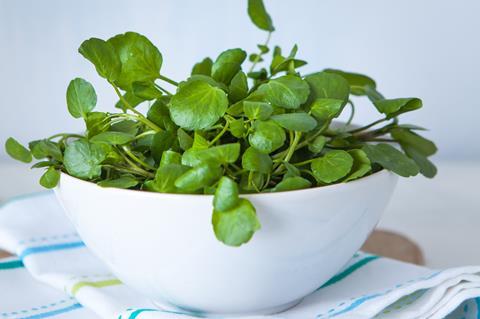Study findings indicate major potential new usage for the crop

New research has suggested that watercress extract from fresh watercress has anti-inflammatory properties for potential use in treating inflamed human skin.
While further work is required to refine the optimal concentration of the extract, the study is being viewed as a major step forward in providing a potential solution for sufferers of eczema and similar skin conditions.
The research was led by Professor Paul Winyard from the University of Exeter Medical School, who, with Dr Kyle Stewart, co-founded Watercress Research Ltd. The company has developed a process to manufacture an aqueous watercress extract that contains isothiocyanates and flavonoid-type polyphenols, some of which are known anti-inflammatory compounds.
Previous studies had indicated that a three per cent concentration of watercress extract significantly reduced inflammation. In the latest research further tests were undertaken on lab-grown skin to assess for cytotoxicity and irritancy before trialling the watercress extract in a human in vivo patch-test-based model of skin inflammation.
A 10 per cent concentration of watercress extract showed clear anti-inflammatory effects in SDS-induced human skin inflammation – Sodium Dodecyl Sulfate disrupts the skin’s protective barrier, leading to inflammation and epidermal thickening – suggesting the extract could be useful in assisting with certain skin irritations.
The work was supported by The Watercress Company, which supplies the fresh watercress from which the extract is made, and which has been championing scientific research into watercress for 20 years.
This latest research builds on studies by The Cyprus Institute of Neurology & Genetics that found that watercress extract, rich in phenethyl isothiocyanate (PEITC), can selectively kill melanoma cells. This in turn was developed from previous work by the Universities of Ulster and Southampton into the effects of watercress on other cancer cells, including lung, bowel and breast cancers.
Key to its success is the compound PEITC, which occurs naturally in watercress in high amounts and is responsible for watercress’ distinctive peppery flavour.
Glucosinolates including PEITC and sulforaphane are thought to underlie some of the key bioactivities of the watercress extract on the skin in the newest research, but watercress also contains a wide array of polyphenols which have been suggested to explain topical anti-inflammatory activity of watercress extracts, so further chemical analysis is needed to provide a better understanding of the observed bioactivities of the extract.
In addition, more testing of different concentrations of the extract are necessary to identify the optimal strength of the compounds needed for best results on skin irritation.
Tom Amery, MD of The Watercress Company, said: “Watercress continues to amaze as science reveals more of its natural secrets. I have witnessed the findings that various academic institutions have unveiled over nearly two decades and am astounded that a simple cultivated semi-aquatic plant can offer so much.
“The research used watercress extract drawn from fresh watercress grown in the same farms that supply most of the UK’s shops year-round. We know that the process of chewing watercress activates the PEITC, so the everyday consumption of watercress releases these anti-inflammatory properties into the body.
“This latest work shows the potential for the same anti-inflammatory properties to be applied topically to relieve uncomfortable and common skin complaints such as eczema from which millions around the world suffer.”



